Bulletin – June 2014 Global Economy Cross-border Capital Flows since the Global Financial Crisis
- Download the article 761KB
Abstract
Global gross capital flows remain well below their peak before the global financial crisis, which was reached after a period of unusual expansion. Much of the decline can be attributed to a reduced flow of lending by banks – particularly to, from and within the euro area – as banks have unwound many of the cross-border positions they built up before the crisis. Capital inflows to some economies, however, are now larger than they were before the crisis. The international regulatory response to the crisis aims to address some of the risks associated with increased capital flows, while maintaining the benefits of an integrated financial system.
Introduction
Gross capital flows are one indicator of international financial integration or financial globalisation.[1] By this measure, the pace of overall financial integration increased markedly in the decade before the global financial crisis (Graph 1). Since then, there has been a well-documented decline in cross-border flows of capital, particularly from the banking sector, such that total annual flows have fallen to around one-third of their size in 2007 (Borio and Disyatat 2011; Broner et al 2013). This article examines recent trends in gross capital flows by their type, origin and destination, and considers some potential consequences for economic growth and financial stability.
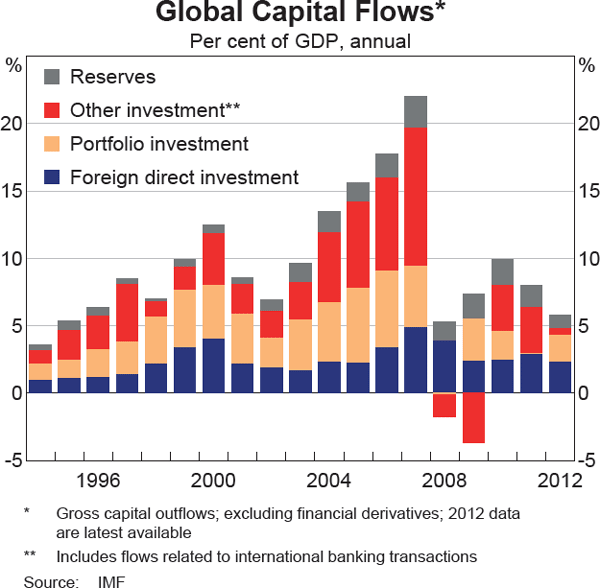
Recent Trends in Cross-border Capital Flows
Relative to the size of the global economy, all major types of capital flows are now smaller than they were in 2007. The fall in ‘other investment’ flows, much of which reflects a fall in cross-border lending by banks, has been particularly pronounced, following a large increase in the pre-crisis period (Table 1).[2] Portfolio investment in debt and equity securities has also declined considerably since the period before the crisis.[3] Direct investment flows, by contrast, have remained relatively stable in recent years, with average flows above those of the 1980s and 1990s.
| Yearly average | |||||||
|---|---|---|---|---|---|---|---|
| 1980–1989 | 1990–1999 | 2000–2007 | 2008–2012 | ||||
| Foreign direct investment | 1.0 | 1.5 | 2.9 | 2.9 | |||
| Portfolio investment | 1.2 | 2.3 | 4.2 | 1.4 | |||
| Other investment(b) | 2.7 | 1.9 | 5.0 | 0.4 | |||
| Reserves(c) | 0.8 | 0.5 | 1.2 | 1.5 | |||
| Total | 5.7 | 6.2 | 13.3 | 6.2 | |||
|
(a) Gross capital outflows; excluding financial derivatives; RBA estimates used for
some capital flows prior to 1994, based on extrapolation of capital outflows
from developed economies Sources: IMF; RBA |
|||||||
More detailed and up-to-date data from the Bank for International Settlements (BIS) show that most of the fall in banking flows is likely to have been accounted for by a fall in interbank lending.[4] Following several years of expansion, cross-border interbank lending declined sharply after the crisis. By contrast, cross-border lending to non-banks (including other financial institutions, non-financial firms and governments) has been relatively resilient following the sharp decline in late 2008 (Graph 2).
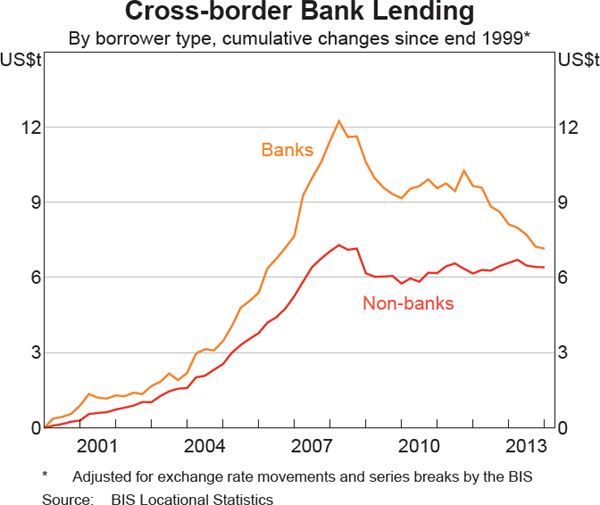
Lower capital flows have coincided with weak macroeconomic and financial conditions in many economies. This has affected both the demand for and supply of capital, with households and businesses (including banks) in many countries less willing or able to take on risk. Other factors, including slower growth of world trade since the crisis, are also consistent with less demand for international capital. Alongside the subdued demand for capital, banks in many economies have actively reduced their supply of credit, as they repair their balance sheets and rebuild capital positions. As banks have deleveraged, cross-border lending has been among the types of lending most heavily affected.
Changes in the Geographical Distribution of Capital Flows
While global flows of bank lending and portfolio investment have both declined since the crisis, there are marked differences across countries. Nearly the entire decline in global capital flows has been accounted for by reduced lending among advanced economies, particularly within Europe, whereas capital flows to emerging economies have generally increased.[5] In some instances, capital flows to emerging economies have been very strong since the crisis, though they have also proved volatile.
Cross-border lending by banks
The increase in banking flows in the years before the crisis – and the sharp overall decline since then – in large part reflected banking flows to, from and within Europe, including flows through the United Kingdom in its role as a major financial centre for Europe (Graph 3 and Graph 4). This is reflected in the change in the cross-border claims of banks in the euro area and the United Kingdom, which respectively account for around one-half and one-third of the fall in the total stock of cross-border banking claims among BIS reporting banks since the crisis.[6] The decline in banking flows over the seven consecutive quarters to December 2013 has also been driven by lenders and borrowers in Europe.
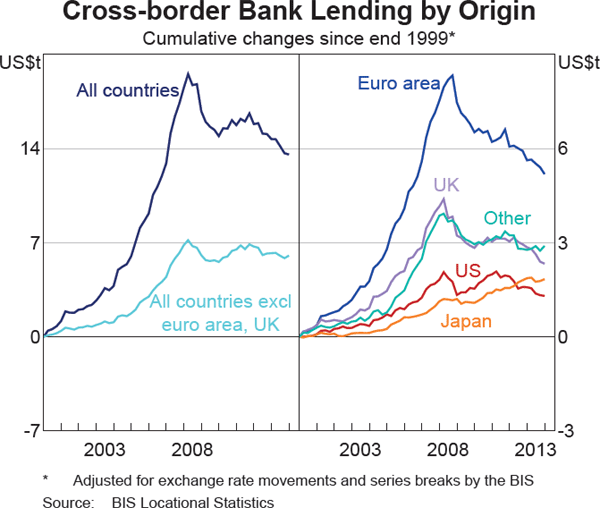
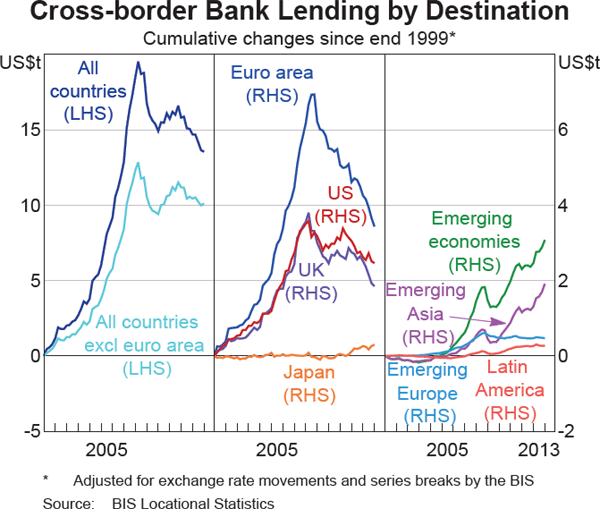
The contraction in European banking flows is consistent with the protracted sovereign debt and banking concerns in the region. Signs of weakness in euro area bank balance sheets, weak macroeconomic conditions and ensuing fiscal strains, as well as concern that countries might exit the currency union, were met by large outflows of capital from those euro area countries on the weakest footing: investors sold down their holdings of foreign sovereign debt; households and businesses repatriated their deposits; and banks reduced their exposures to the euro area. Some of the sovereign debt and deposit outflows have reversed since the second half of 2012 as measures were taken to stabilise conditions in the euro area (ECB 2014). Nevertheless, cross-border lending by banks in the euro area has continued to decline, and the slow process of balance sheet repair by banks, households, businesses and governments has continued to act as a drag on capital flows.
Outside Europe, the volume of cross-border bank lending to and from some other countries has expanded since the global financial crisis, particularly for economies that have grown relatively quickly. Inflows have been strongest to markets in emerging Asia: lending to China has accounted for the majority of the increase, although lending to India, Indonesia and Malaysia has also risen notably (Graph 5, left panel). In the case of China and Malaysia, this lending has also been rising relative to the size of their economies (Graph 5, right panel). This is true also of Hong Kong, for which cross-border bank lending has increased to about 200 per cent of GDP (from around 100 per cent in 2007). This relatively high level in part reflects its status as an international financial centre and its close relationship with mainland China.[7]
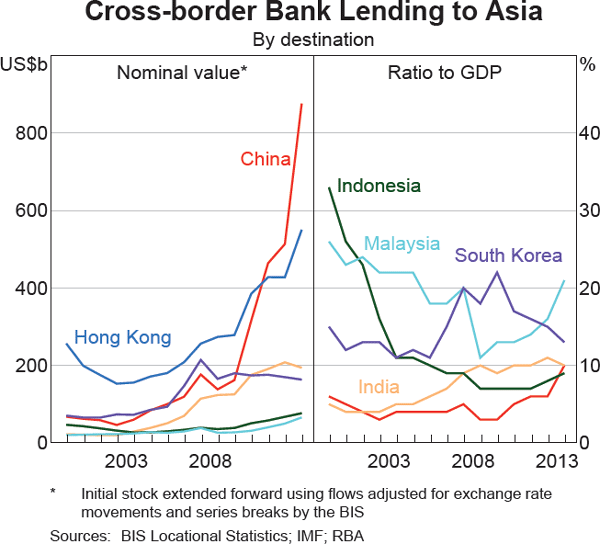
Japanese banks have intermediated a large proportion of the increase in lending to emerging Asia, reflecting a decision by some of these banks to increase foreign lending as other international banks have retreated. Banks from Hong Kong, Korea and Taiwan have also significantly increased their lending to the region since the crisis. More broadly, local banks in emerging economies have generally increased their presence in domestic and regional financial systems, although emerging economies still make up only a small share of total cross-border lending by banks (CGFS 2014). These developments have been reflected in a number of changes in the overall stock of cross-border bank lending accounted for by countries in advanced and emerging economies (Table 2).
| Origin | Destination | ||||
|---|---|---|---|---|---|
| 2008 | 2013 | 2008 | 2013 | ||
| Major advanced economies(a) | 80 | 77 | 74 | 68 | |
| Japan | 8 | 11 | 2 | 3 | |
| Euro area | 40 | 35 | 36 | 30 | |
| Asia excl Japan(b) | na | na | 5 | 9 | |
| Other emerging economies | na | na | 6 | 7 | |
| Other advanced economies | na | na | 15 | 16 | |
|
(a) Includes the euro area, Japan, Switzerland, the United Kingdom and the United
States Source: BIS Locational Statistics |
|||||
Portfolio investment
A clear distinction between some advanced and emerging economies is also apparent in the evolution of portfolio flows since the crisis. Portfolio flows to the major advanced economies have declined sharply, especially debt flows, which remain around two-thirds below their pre-crisis peak (Graph 6). As in the case of lending by banks, the fall has been starkest for the euro area and the United Kingdom. In contrast, portfolio flows to many emerging economies have been strong overall, and debt inflows appear to have increased, notwithstanding periods of volatility. This trend has been apparent in Indonesia and Malaysia, where local bond markets are more developed (IMF 2011). Emerging market corporate bond issuance has been resilient in the post-crisis period (Graph 7).
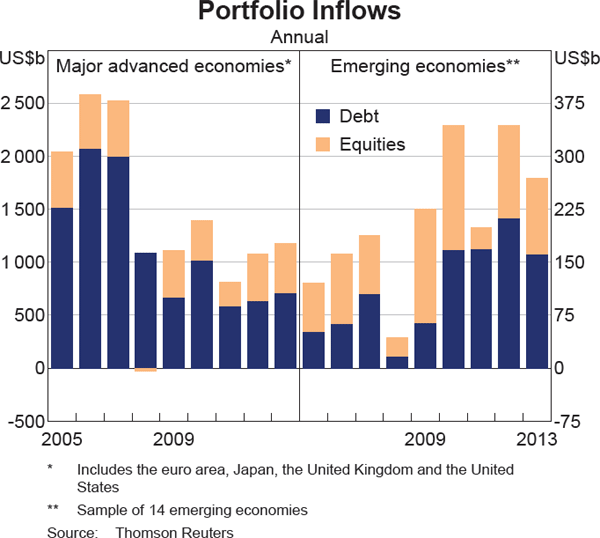
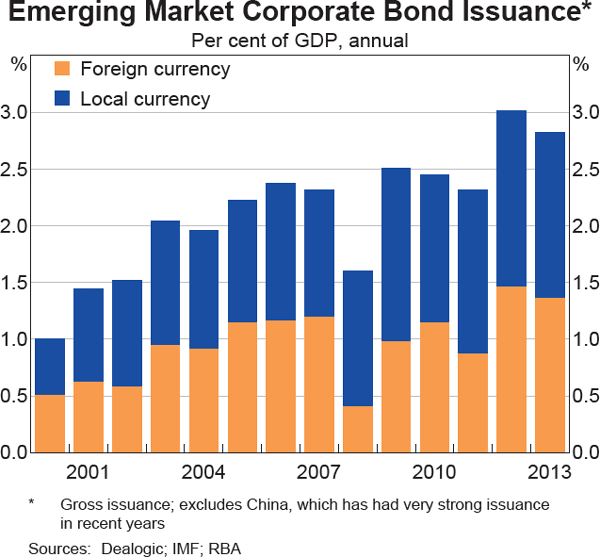
More broadly, the increase in capital flows to emerging economies is likely being driven, in part, by structural factors: as emerging economies expand and trade links with the rest of the world grow, it would be natural that their share of global capital flows would increase. Cyclical conditions will have also played a role, as economic growth has been much stronger in emerging economies relative to advanced economies since the crisis.
Accommodative monetary policies in the major advanced economies have been another factor behind capital inflows into emerging economies. With interest rates in most advanced economies at record lows, investors have been encouraged to seek out higher-yielding assets. As yields on advanced economy assets have fallen, the higher yields on offer in emerging economies have drawn large inflows of capital to emerging market bond and equity funds.
Even so, emerging market economies have remained susceptible to bouts of volatility in capital flows. To some extent this reflects a natural process of markets repricing risks across asset classes, with economies assessed as most vulnerable on metrics of external debt, fiscal sustainability and future economic activity typically experiencing larger capital outflows.
Cross-border Capital Flows and Financial Stability
Economic theory suggests that international capital flows can boost growth and be a source of resilience for individual economies. While capital flows can provide financial stability benefits, including diversification from idiosyncratic risk, they also make financial conditions more correlated across jurisdictions and create channels for contagion. Indeed, the global financial crisis highlighted the fact that increased financial flows cannot always be assumed to result in a better distribution of risks, at the institution level or the country level, and may in fact amplify them (Obstfeld 2012).
In responding to weaknesses exposed by the financial crisis, global policymakers face a potential trade-off between minimising possible threats to financial stability and seeking to promote the benefits of an integrated financial system. There are difficulties calibrating the system-wide costs and benefits of different types of capital flows and the policies that seek to constrain or promote them.
While some studies have found that international capital flows can boost productive capacity, expand opportunities for diversification and increase liquidity in financial markets, other studies have raised questions about the strength of these relationships. For example, there is only qualified evidence that greater ‘financial openness’ leads to improved risk sharing (Kose, Prasad and Terrones 2007; Obstfeld 2012). Similarly, it is difficult to establish a causal relationship between capital flows and economic growth, using the available data, once controls are made for other determinants of growth (Kose et al 2009). More recent studies have suggested that capital flows may even start to drag on economic growth once they increase beyond a certain size (BIS 2012).
In weighing the advantages and disadvantages of capital flows, it may be important to distinguish between the types of capital. Cross-border lending by banks over the past decade, for instance, was highly procyclical (Graph 8). Indeed, there is a growing literature documenting the volatility of foreign bank lending and the large volume of interbank lending undertaken per dollar of lending to the real economy (Hoggarth, Hooley and Korniyenko 2013; Turner 2014). Flows of direct investment and portfolio equity, by contrast, were more stable over the years around the financial crisis and have stronger empirical links with long-term growth (Kose et al 2009).[8]
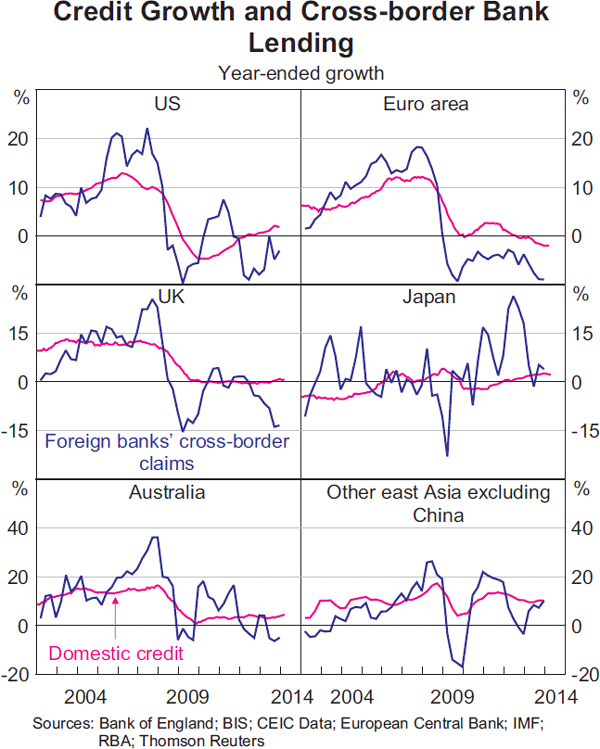
Regulatory responses to the crisis
The international regulatory response to the crisis has led to a range of reforms, including standards on the resilience and resolvability of internationally active banks, as well as policies to reduce risks in the over-the-counter derivatives and shadow banking markets.[9] These reforms generally aim to reduce interconnectedness and opacity in the global financial system and increase its resilience to shocks. In addition, several reforms are targeted at risks arising from banks' cross-border transactions, including mismatches in the maturity and currency of their assets and liabilities. Improving cross-border supervisory and regulatory cooperation has also been an important part of the response to the crisis. Reforms that impose greater control on cross-border activities include:
- Reforms to the Basel Capital Accord (including higher risk weights for certain trading book assets and enhanced requirements for the quantity and quality of capital under Basel III) require banks to price their risk more accurately and deploy capital more prudently across their retail and wholesale businesses. In adjusting to these reforms, some large banks have pared back their international activities to refocus on businesses in their domestic markets, which are often more familiar, less complex and require less capital.
- The Basel III reforms include two new standards for liquidity management: the Liquidity Coverage Ratio and the Net Stable Funding Ratio. The standards require banks to hold more liquid assets and use more stable, long-term sources of funding. In combination with these standards, regulators have supported banks' own efforts to better manage funding mismatches in their balance sheets. Before the crisis, some banks used a network of branches and subsidiaries to raise deposits and wholesale funding in one jurisdiction for lending in another. Maintaining these intragroup flows proved unsustainable when funding markets became stressed – a problem that was exacerbated by mismatches in the maturity, currency and residency of banks' assets and liabilities.
- Reforms for systemically important financial institutions (SIFIs) are aimed at reducing both the probability and impact of their failure. The cross-border funding and lending practices of many banks before the crisis made them quite complex and interconnected, and therefore hard to resolve. In response, regulators have introduced new capital surcharges for SIFIs, enhanced their recovery and resolution planning, and increased the intensity of their supervision. Countries are also working towards reforming their financial systems and legal frameworks to meet the new global standard for resolving financial institutions, as set out in the Key Attributes of Effective Resolution Regimes for Financial Institutions (FSB 2011).
International reforms have been complemented in some jurisdictions by national initiatives to enhance the supervision of foreign-owned banks and make it easier to resolve those that might fail. These efforts may also be weighing on cross-border lending (McKinsey Global Institute 2013). This is partly because regulators in several jurisdictions will require that large foreign banks are ‘ring-fenced’ into entities that are legally and operationally independent. In such cases, a foreign bank would have to hold capital and liquidity locally, rather than relying on their parent for support.
- In the United Kingdom, regulators are considering reforms that could require foreign bank branches to incorporate as a subsidiary if their home country supervision and resolution arrangements are not sufficiently ‘equivalent’ to those in the United Kingdom.
- In the United States, the Federal Reserve finalised a rule in February that will require large ‘foreign banking organisations’ to consolidate their bank and non-bank subsidiaries under an ‘intermediate holding company’, which would be subject to supervisory requirements generally applicable to US bank holding companies.
- The trend towards greater ring-fencing is being reinforced by ‘structural banking reforms’ in the United States, the United Kingdom and the European Union (the Volcker, Vickers and Liikanen proposals, respectively). These reforms will force banks to transfer some or all of their investment banking and high-risk wholesale banking activities into a separately capitalised subsidiary, and cease certain speculative trading activities entirely (Gambacorta and Van Rixtel 2013).
By seeking to make banks simpler, less interconnected and easier to resolve, these reforms aim to increase the resilience of the financial system and reduce the risk that taxpayers or depositors will incur losses if a bank fails. Some observers have expressed concern, however, that these reforms could come at the cost of making the global financial system more fragmented. Nevertheless, given the costs arising from the global financial crisis, the case for regulatory change to alleviate shortcomings revealed by the crisis remains strong.
Conclusion
While global gross capital flows are now lower than they were in 2007, this reduction has not been broad based across economies and all types of capital flows. Much of the decline reflects a reduction in flows to and from advanced economies, with the fall most pronounced in portfolio flows and cross-border lending by banks. In contrast, capital inflows to some economies have increased since the crisis, particularly those to emerging Asia. These changes in the volume, type and geographical distribution of capital flows have reflected a broad reassessment of risk across jurisdictions and asset classes, as well as other cyclical and structural factors.
Footnotes
The authors completed this work in Financial Stability and International Departments. [*]
At the global level, gross capital flows can be calculated as the sum of capital inflows or the sum of capital outflows. The size of global inflows and outflows should be roughly the same, though there are frequently small differences because of measurement problems. [1]
The International Monetary Fund's (IMF's) Balance of Payment statistics identify five main types of capital flows: foreign direct investment, where an investor takes an equity stake of 10 per cent or more in a company; portfolio investment, which includes smaller equity investments and purchases of debt securities; reserves, which are foreign currency assets held by monetary authorities; transactions in derivatives; and ‘other investment’, which is a residual category that includes, among other things, lending by banks and international organisations. Transactions in derivatives are excluded from this analysis as the timing and magnitude of these flows are difficult to interpret. [2]
Only considering portfolio investment from an outflows perspective somewhat amplifies the extent of the post-crisis decline in portfolio flows. From an inflows perspective, portfolio investment as a per cent of GDP is in line with its 1990s average, though still well below pre-crisis activity. Strength in reserves outflows since the crisis has contributed to the higher volume of portfolio inflows, as much of what is recorded as outflows of reserves from one country will appear as inflows of portfolio investment into another country. [3]
This article uses the locational data published by the BIS in the International Banking Statistics. Locational data measure the gross claims of banks located in a reporting country on entities in other jurisdictions – that is, the claims of domestically owned banks and foreign-owned branches and subsidiaries. Cross-border claims include loans and advances, deposits and balances with other banks, as well as holdings of debt securities. Because the data are unconsolidated, they include cross-border lending between branches and subsidiaries of the same banking group. The BIS also publishes data on a consolidated basis. [4]
Gross capital flows to and from the Australian economy have declined since the crisis, though by somewhat less than in the major advanced economies. A decline in flows to and from the Australian banking sector has occurred alongside an increase in direct investment flows to non-financial corporations, particularly to the resources sector, and an increase in foreign purchases of Australian government debt (Debelle 2014). [5]
BIS reporting banks span around 45 countries, encompassing some 85 per cent of the global banking system. Developments in cross-border bank lending are expected to be closely related to the cross-border banking flows captured in the broader ‘other investment’ category used by the IMF, although some elements of cross-border bank lending will be reflected in the IMF's portfolio and direct investment flow categories. [6]
Much of the increase in lending to China has been by banks in Hong Kong, which have also increased lending to other countries in the region by a significant amount since 2009. It is likely that much of the increase in cross-border bank lending to Hong Kong reflects lending by Chinese banks, though this cannot be verified using the BIS banking statistics. [7]
That said, the literature on international capital flows offers mixed conclusions about the preferred composition of capital flows. Becker and Noone (2009), for instance, look at advanced economies and find little evidence that some types of capital flows are more conducive to a stable capital account than others. [8]
For more information on the international regulatory response to the financial crisis, see Schwartz (2013). [9]
References
Becker C and C Noone (2009), ‘Volatility in International Capital Movements’, RBA Research Discussion Paper No 2009-09.
BIS (Bank for International Settlements) (2012), ‘The Future of Financial Globalisation’, BIS Papers No 69.
Borio C and P Disyatat (2011), ‘Global Imbalances and the Financial Crisis: Link or No Link?’, BIS Working Paper No 346.
Broner F, T Didier, A Erce and S Schmukler (2013), ‘Gross Capital Flows: Dynamics and Crises’, Journal of Monetary Economics, 60(1), pp 113–133.
CGFS (Committee on the Global Financial System) (2014), ‘EME Banking Systems and Regional Financial Integration’, CGFS Papers No 51.
Debelle G (2014), ‘Capital Flows and the Australian Dollar’, Speech to the Financial Services Institute of Australia, Adelaide, 20 May.
ECB (European Central Bank) (2014), Financial Integration in Europe, European Central Bank, Frankfurt.
FSB (Financial Stability Board) (2011), Key Attributes of Effective Resolution Regimes for Financial Institutions, October. Available at <http://www.financialstabilityboard.org/publications/r_111104cc.pdf>.
Gambacorta L and A Van Rixtel (2013), ‘Structural Bank Regulation Initiatives: Approaches and Implications’, BIS Working Papers No 412.
Hoggarth G, J Hooley and Y Korniyenko (2013), ‘Which Way do Foreign Branches Sway? Evidence from the Recent UK Domestic Credit Cycle’, Bank of England Financial Stability Paper No 22.
IMF (International Monetary Fund) (2011), Regional Economic Outlook: Asia and Pacific – Sustaining the Momentum: Vigilance and Reforms, World Economic and Financial Surveys, April, International Monetary Fund, Washington, DC.
Kose MA, E Prasad and M Terrones (2007), ‘How Does Financial Globalization Affect Risk Sharing? Patterns and Channels’, IMF Working Paper WP/07/238.
Kose MA, E Prasad, K Rogoff and S Wei (2009), ‘Financial Globalization: A Reappraisal’, IMF Staff Papers, 56(1), pp 8–62.
McKinsey Global Institute (2013), ‘Financial Globalization: Retreat or Reset?’, March. Available at <http://www.mckinsey.com/insights/global_capital_markets/financial_globalization>.
Obstfeld M (2012), ‘Financial Flows, Financial Crises, and Global Imbalances’, Journal of International Money and Finance, 31(3), pp 469–480.
Schwartz C (2013), ‘G20 Financial Regulatory Reforms and Australia’, RBA Bulletin, September, pp 77–85.
Turner A (2014), ‘Too Much of the Wrong Sort of Capital Flow’, Paper presented at the Conference on Capital Account Management and Macro-Prudential Regulation for Financial Stability and Growth, Centre for Advanced Financial Research and Learning and Reserve Bank of India, New Delhi, 13 January.